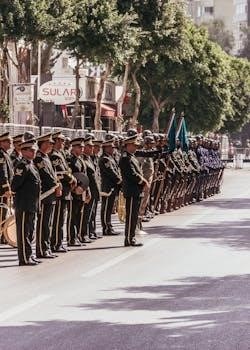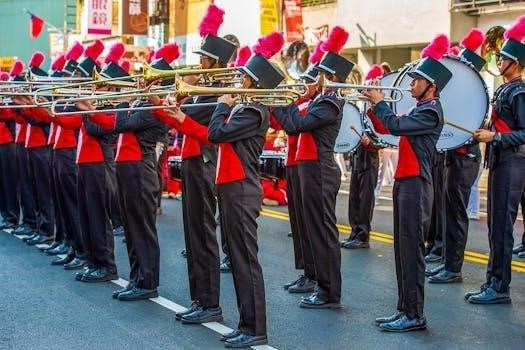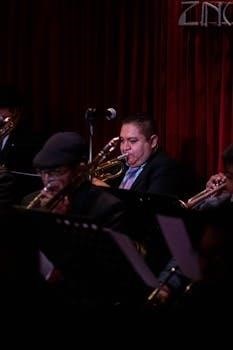Bordogni Trombone PDF⁚ A Comprehensive Guide
This guide explores the world of Bordogni’s vocalises, adapted for trombone, available in PDF format. We will delve into various editions, focusing on their unique features and pedagogical applications. From Mulcahy’s comprehensive work to Rochut’s melodious selections, we will uncover the nuances of these essential studies. This resource provides you with a roadmap for understanding and utilizing these valuable exercises.
Marco Bordogni, an Italian operatic tenor and renowned singing teacher, born in 1789, left an indelible mark on vocal pedagogy. His vocalises, originally crafted for voice training, have found widespread use in instrumental instruction, particularly for trombone. Bordogni’s etudes, though not originally intended for trombone, are celebrated for their melodic beauty and focus on legato phrasing, making them invaluable for developing musicality and breath control. His career, primarily based in Paris, was marked by both performance success and a commitment to teaching. The adaptability of his vocalises makes them a cornerstone of trombone pedagogy. Bordogni’s legacy is not limited to vocal training, but extends to shaping the instrumental techniques of countless musicians. Through these transcribed etudes, students of the trombone are given a unique insight into the principles of singing, allowing for the refinement of their own musical expression and technical proficiency. His work provides a bridge between vocal and instrumental performance practices.

The Significance of Bordogni’s Vocalises for Trombone
Bordogni’s vocalises hold immense significance for trombone players due to their inherent focus on legato playing, musical phrasing, and breath control. Originally designed to cultivate vocal technique, these etudes translate remarkably well to the trombone, providing a platform for developing a smooth, singing tone. The melodic nature of the etudes encourages a focus on musicality, compelling players to think beyond mere technical proficiency. By adapting vocal exercises, trombonists learn to shape phrases with intention and nuance. Furthermore, the sustained passages in Bordogni’s works demand careful management of breath and air support, crucial for developing proper trombone playing. The vocal nature of the etudes promotes an understanding of musical line and expression. Ultimately, Bordogni’s vocalises offer a holistic approach to trombone playing, fostering both technical skill and artistic interpretation. The emphasis on legato is paramount, allowing trombonists to emulate the fluidity of the human voice.
Key Editions of Bordogni Etudes for Trombone
Several key editions of Bordogni’s etudes for trombone exist, each offering a unique approach to the material. Michael Mulcahy’s edition is highly regarded for its comprehensive text covering interpretation and style, alongside clear notation and advanced studies. Rochut’s “Melodious Etudes” is another essential resource, focusing on the lyrical aspects of the studies. Furthermore, Keith Brown’s “24 Legato Studies” provides a focused selection of exercises designed to improve legato technique. These editions vary in their selection and presentation of the original vocalises. Some editions also include piano accompaniments, enhancing the musical experience for practice and performance. Each of these editions serves as a valuable tool for trombonists of all levels. Understanding the nuances of each edition allows players to choose resources that best suit their individual needs and technical goals. These different approaches to Bordogni’s work ensure that the etudes remain relevant and adaptable for all trombonists.

Michael Mulcahy’s Edition⁚ Features and Contributions
Michael Mulcahy’s edition of the Bordogni etudes stands out as a premier resource for trombonists. This edition includes all 120 of Bordogni’s vocalises, providing a complete collection for study. A significant feature is the extensive text, which delves into interpretation, style, and techniques such as natural and tongued legato. Mulcahy’s contribution extends to providing clear, error-free notation, making the studies accessible and reliable for practice. The inclusion of advanced studies in both tenor and alto clef caters to a broad range of players. Furthermore, the edition offers several complete interpretations by Mulcahy himself, serving as excellent models for performance. The edition also draws from Bordogni’s original piano accompaniments, ensuring compatibility for ensemble practice. Overall, Mulcahy’s edition provides a rich and comprehensive approach to mastering the Bordogni etudes, establishing itself as a crucial resource for trombonists seeking excellence.
Rochut’s Melodious Etudes⁚ A Detailed Look
Rochut’s edition of Bordogni’s vocalises, often titled “Melodious Etudes for Trombone,” is a cornerstone in trombone pedagogy. This adaptation focuses on extracting the most musically beneficial etudes for instrumental practice. Rochut’s selections, typically presented in two books, prioritize melodic phrasing and legato development. The etudes are carefully chosen to enhance a player’s musicality and control. While drawing from Bordogni’s original vocalises, Rochut’s edition presents them in a manner particularly suited for trombone. This makes them essential for developing a smooth and expressive tone. The emphasis is on legato playing, but also on broader musicality, encouraging players to infuse their interpretations with creativity and style. Rochut’s work is designed to challenge trombonists to explore the beauty and potential within these vocalises. The edition is widely used and respected in trombone circles for its effectiveness in developing both technical and musical skills.
Keith Brown’s 24 Legato Studies
Keith Brown’s edition, “24 Legato Studies (Vocalises) for Trombone,” presents a focused approach to developing legato technique through Bordogni’s material. This selection of 24 studies is specifically designed to enhance a trombonist’s ability to play with a smooth and connected sound. Brown’s edition emphasizes the importance of legato phrasing as a foundation for musical expression. These studies, derived from Bordogni’s vocalises, are carefully chosen to challenge a player’s control and breath support. The focus is not only on technical proficiency but also on the musicality of each phrase. Brown’s approach encourages players to think like singers, focusing on the continuity of the melodic line. This method is invaluable for developing a beautiful tone and expressive phrasing. The edition is a popular choice among teachers and students for its clear and concise approach to legato practice. These studies serve as an essential tool in a trombonist’s development, fostering both technical and artistic growth.

Analyzing the Content of Bordogni Trombone PDFs
Exploring Bordogni trombone PDFs reveals a wealth of material primarily derived from his vocalises. These PDFs typically contain a collection of melodic studies, originally intended for voice but adapted for the trombone. The content often includes a range of exercises focusing on legato playing and phrasing. Many editions present the etudes in a progressive manner, gradually increasing in difficulty. A standard PDF will feature clear notation, with some editions offering additional markings for articulation and dynamics. Some PDFs also incorporate piano accompaniments, enhancing the musicality of the practice. The content may vary depending on the specific edition, with some presenting a select number of studies and others offering the complete collection. Furthermore, certain editions include text analyzing the etudes, offering insights into performance practices and style. By carefully examining these PDF contents, trombonists can greatly enhance their musical and technical skills. The format is straightforward, allowing for easy access and study.
Interpretation and Style Markings
Bordogni trombone PDFs often include essential guidance on interpretation and style. These markings are crucial for understanding the musical intention behind each etude, originally conceived as vocal exercises. PDFs might feature indications for legato phrasing, shaping of melodic lines, and dynamic variations. Editors like Michael Mulcahy provide extensive notes on stylistic considerations, advising trombonists on how to approach the music with a singing quality. The style markings frequently encourage a cantabile approach, emphasizing smooth connections between notes and expressive phrasing. Specific markings might include slurs, accents, and dynamic indications like crescendo and diminuendo, shaping the musical contour. These annotations provide a framework for individual interpretation, encouraging players to develop their own sense of musicality. Many editions offer examples of interpretations, helping students understand the nuances and subtleties of the music. By carefully considering these markings, players can bring life and artistry to their performance of the Bordogni etudes. The goal is to create a musical and expressive experience, not just a technical exercise.
Technical Aspects⁚ Legato and Tonguing
Bordogni trombone PDFs are invaluable for honing specific technical skills, especially legato and tonguing. The etudes, designed for vocal training, translate exceptionally well to the trombone for developing a smooth, connected sound. Legato is paramount; the exercises emphasize seamless transitions between notes without any breaks or harshness. Players learn to control breath support and air flow to achieve a fluid melodic line. Tonguing, often used subtly, must be light and precise to not interrupt the legato. The PDF resources frequently include instructions on different tonguing styles, such as legato tonguing, allowing for articulation without sacrificing the connected nature of the phrase. These etudes help build consistency in both legato and tonguing, demanding control and precision at varying tempos and dynamics. Through consistent practice of these exercises, trombonists develop a refined technique. The focus is on blending articulation seamlessly into a legato phrase, enhancing overall musicality. Mastering these technical aspects significantly elevates a trombonist’s overall performance.
Piano Accompaniments and Their Role
Piano accompaniments play a vital role in enriching the study of Bordogni trombone PDFs. While the original vocalises were often performed with piano, many trombone editions include these accompaniments, enhancing both practice and performance experiences. The piano parts provide a harmonic context, allowing trombonists to hear the melody within a fuller musical setting. These accompaniments help in developing a sense of phrasing and musicality, guiding the player through dynamic nuances and tempo variations. Moreover, the piano’s presence encourages a more collaborative approach to the music, highlighting the interplay between melody and harmony. Some editions offer audio recordings of piano accompaniments, which are invaluable for learning proper timing and musical interpretation. The availability of piano accompaniments, often in PDF format alongside the trombone part, makes practicing more engaging and effective. These resources transform etudes into fully realized musical pieces, enabling trombonists to develop a deeper understanding of musical expression. Practicing with piano accompaniment facilitates better intonation and rhythm.
Accessing Free Bordogni Trombone PDFs
Many resources online offer free Bordogni trombone PDFs, making these essential etudes accessible to a wide range of musicians. Several websites provide downloadable files of various Bordogni vocalises, often in arrangements for trombone. These free PDFs can include selections from different editions, allowing players to explore various interpretations and arrangements. It’s essential to be aware that the quality and accuracy of these free PDFs may vary; therefore, comparing multiple sources is advisable. Some sites offer individual etudes, while others provide complete books, such as selections from Rochut’s or Brown’s editions. When searching, use specific keywords, like “Bordogni trombone PDF free” or “Rochut etudes trombone PDF free,” to refine your search. Be sure to check the legitimacy of the source, as some files might be pirated or of low quality. Always ensure that the PDF is clear and legible before using it for practice. These easily accessible resources are an advantage for students and educators seeking supplementary material.

Applications of Bordogni Etudes in Trombone Pedagogy
Bordogni etudes, originally for voice, hold a prominent place in trombone pedagogy. They serve as fundamental tools for developing essential skills. Teachers frequently use these studies to cultivate legato phrasing, a cornerstone of expressive trombone playing. The melodic nature of the etudes encourages students to focus on musicality and tone quality. Furthermore, the exercises are effective for improving breath control and developing a consistent airflow. Students also benefit from practicing various articulations, including legato and varied tonguing, as the etudes’ structure lends itself well to these technical studies. Bordogni’s work also strengthens a student’s ear by focusing on intervals and melodic contour. The etudes’ adaptability allows instructors to tailor them to different skill levels, making them valuable for both beginners and advanced players. Bordogni’s vocalises are used not just for technical training, but also for fostering interpretative skills, ensuring well-rounded trombone development. The exercises are crucial for building a strong foundation in musical expression and technical proficiency.
